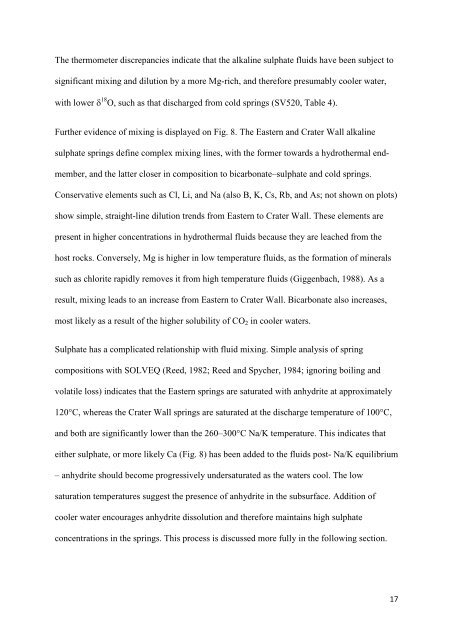Alkaline sulphate fluids produced in a magmatic hydrothermal system
Alkaline sulphate fluids produced in a magmatic hydrothermal system
Alkaline sulphate fluids produced in a magmatic hydrothermal system
You also want an ePaper? Increase the reach of your titles
YUMPU automatically turns print PDFs into web optimized ePapers that Google loves.
The thermometer discrepancies <strong>in</strong>dicate that the alkal<strong>in</strong>e <strong>sulphate</strong> <strong>fluids</strong> have been subject to<br />
significant mix<strong>in</strong>g and dilution by a more Mg-rich, and therefore presumably cooler water,<br />
with lower δ 18 O, such as that discharged from cold spr<strong>in</strong>gs (SV520, Table 4).<br />
Further evidence of mix<strong>in</strong>g is displayed on Fig. 8. The Eastern and Crater Wall alkal<strong>in</strong>e<br />
<strong>sulphate</strong> spr<strong>in</strong>gs def<strong>in</strong>e complex mix<strong>in</strong>g l<strong>in</strong>es, with the former towards a <strong>hydrothermal</strong> endmember,<br />
and the latter closer <strong>in</strong> composition to bicarbonate–<strong>sulphate</strong> and cold spr<strong>in</strong>gs.<br />
Conservative elements such as Cl, Li, and Na (also B, K, Cs, Rb, and As; not shown on plots)<br />
show simple, straight-l<strong>in</strong>e dilution trends from Eastern to Crater Wall. These elements are<br />
present <strong>in</strong> higher concentrations <strong>in</strong> <strong>hydrothermal</strong> <strong>fluids</strong> because they are leached from the<br />
host rocks. Conversely, Mg is higher <strong>in</strong> low temperature <strong>fluids</strong>, as the formation of m<strong>in</strong>erals<br />
such as chlorite rapidly removes it from high temperature <strong>fluids</strong> (Giggenbach, 1988). As a<br />
result, mix<strong>in</strong>g leads to an <strong>in</strong>crease from Eastern to Crater Wall. Bicarbonate also <strong>in</strong>creases,<br />
most likely as a result of the higher solubility of CO 2 <strong>in</strong> cooler waters.<br />
Sulphate has a complicated relationship with fluid mix<strong>in</strong>g. Simple analysis of spr<strong>in</strong>g<br />
compositions with SOLVEQ (Reed, 1982; Reed and Spycher, 1984; ignor<strong>in</strong>g boil<strong>in</strong>g and<br />
volatile loss) <strong>in</strong>dicates that the Eastern spr<strong>in</strong>gs are saturated with anhydrite at approximately<br />
120°C, whereas the Crater Wall spr<strong>in</strong>gs are saturated at the discharge temperature of 100°C,<br />
and both are significantly lower than the 260–300°C Na/K temperature. This <strong>in</strong>dicates that<br />
either <strong>sulphate</strong>, or more likely Ca (Fig. 8) has been added to the <strong>fluids</strong> post- Na/K equilibrium<br />
– anhydrite should become progressively undersaturated as the waters cool. The low<br />
saturation temperatures suggest the presence of anhydrite <strong>in</strong> the subsurface. Addition of<br />
cooler water encourages anhydrite dissolution and therefore ma<strong>in</strong>ta<strong>in</strong>s high <strong>sulphate</strong><br />
concentrations <strong>in</strong> the spr<strong>in</strong>gs. This process is discussed more fully <strong>in</strong> the follow<strong>in</strong>g section.<br />
17
















